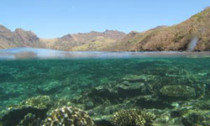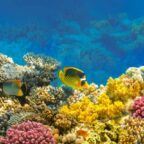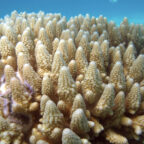
Increasing forest protection in the right areas could increase benefits up to 10.4 percent to coral reef condition, according to a recent study of Fiji’s forests and reefs in Marine Policy. Benefits from protected forests such as improved water quality due to decreased runoff and increased distribution of the vegetation are more closely linked to coral reef health than previously thought.
Researchers from the University of Queensland and the Wildlife Conservation Society modeled six different scenarios for improving Fiji’s coral reefs through the management of their forests. The aim of four of the scenarios was to fulfill Fiji’s terrestrial conservation goals, such as increasing plant representation, while the other two attempted to maximize benefits to coral reefs, by minimizing potential for land-based runoff.
However, the results from the study revealed that any increase in forest protection benefited coral reefs because of a decrease in sediments, nutrients, and pollutants in the rivers that lead to the oceans.
“Small adjustments to the proposed terrestrial protected areas can deliver large benefits to coral reefs,” Carissa Klein of the University of Queensland told mongabay.com, “This run-off can cause die-offs of coral reefs which indirectly affects fisheries… [an industry that] supports the livelihoods of 12 percent of the world’s population.”
The scenarios that focused solely on terrestrial conservation goals experienced 7.7-10.4 percent increases in coral reef benefits. While the benefits to coral reefs were 1.1-2.8 times greater when the priority was to protect coral reefs, 31-44% of the terrestrial conservation goals were not achieved.
Currently, only 5.8 percent of Fiji’s remaining native forests and 3 percent of its total land are protected. Scientists have proposed a set of 40 “priority” forests, based on ecological and socioeconomic goals, across the country covering 58 percent of the native forests and 23 percent of total land for conservation management. This would fulfill the government’s goal of designating at least 20 percent of the total land and 30 percent of the inshore water as protected by 2020. Members of Fiji’s Protected Area Committee designated thirteen of these forests to be placed in the even more earnest category of “high priority” sites for protection because of the feasibility due to financing.
Historically, Fiji’s terrestrial protected areas have been established in an ad hoc manner without particular attention to ecological values. However, this small island country is innovative in their national Protected Area Committee, which comprises both government and non-government representatives from terrestrial and marine divisions allowing for integrated decision-making on the management of the two ecosystems.
The Protected Area Committee is already using the study’s results to assist in land management for the future in this vital area.















Social Profiles